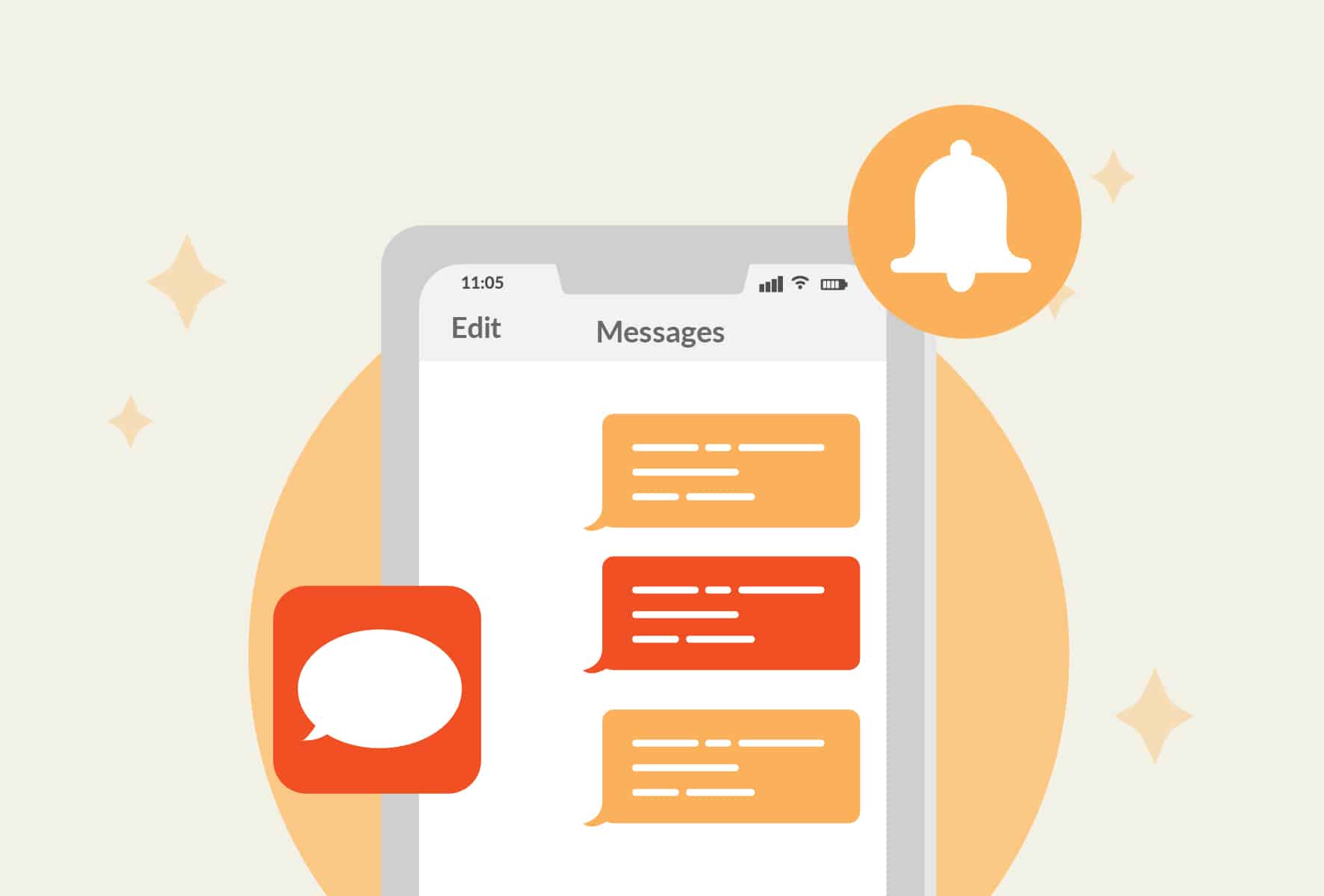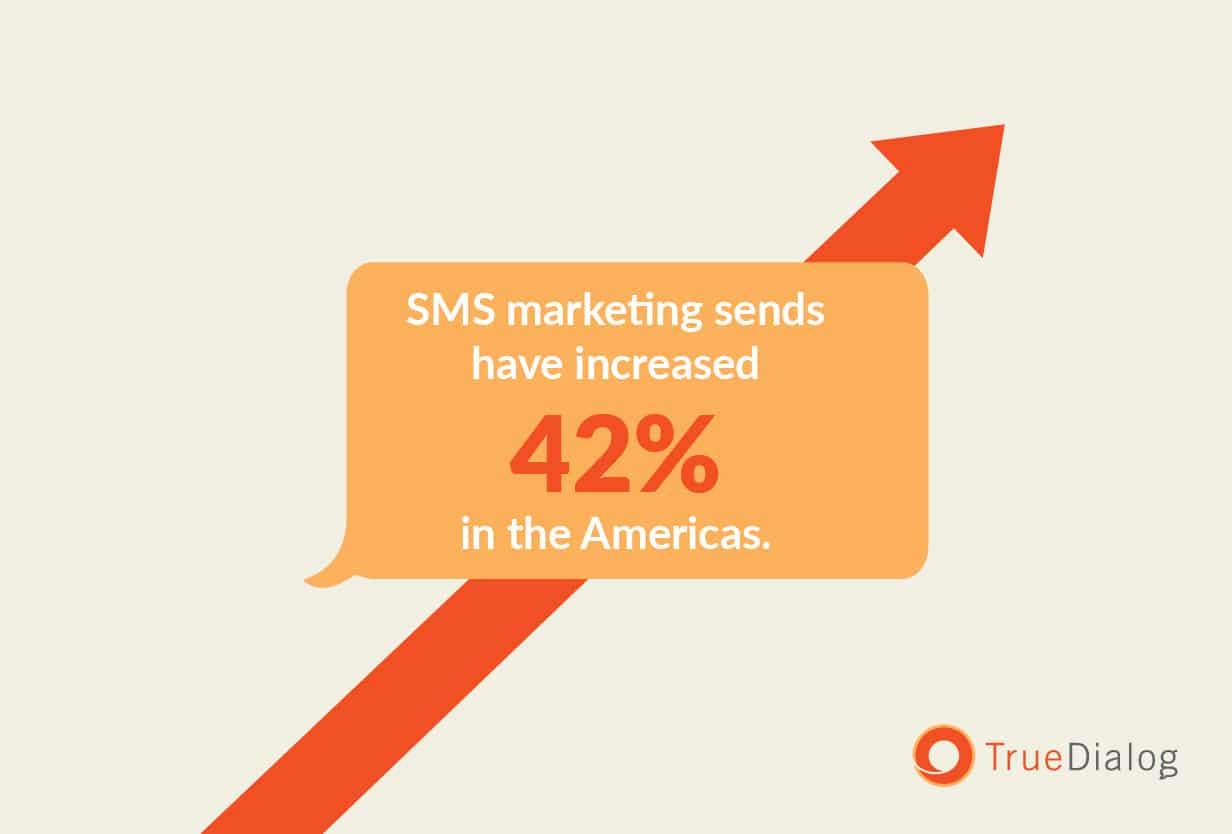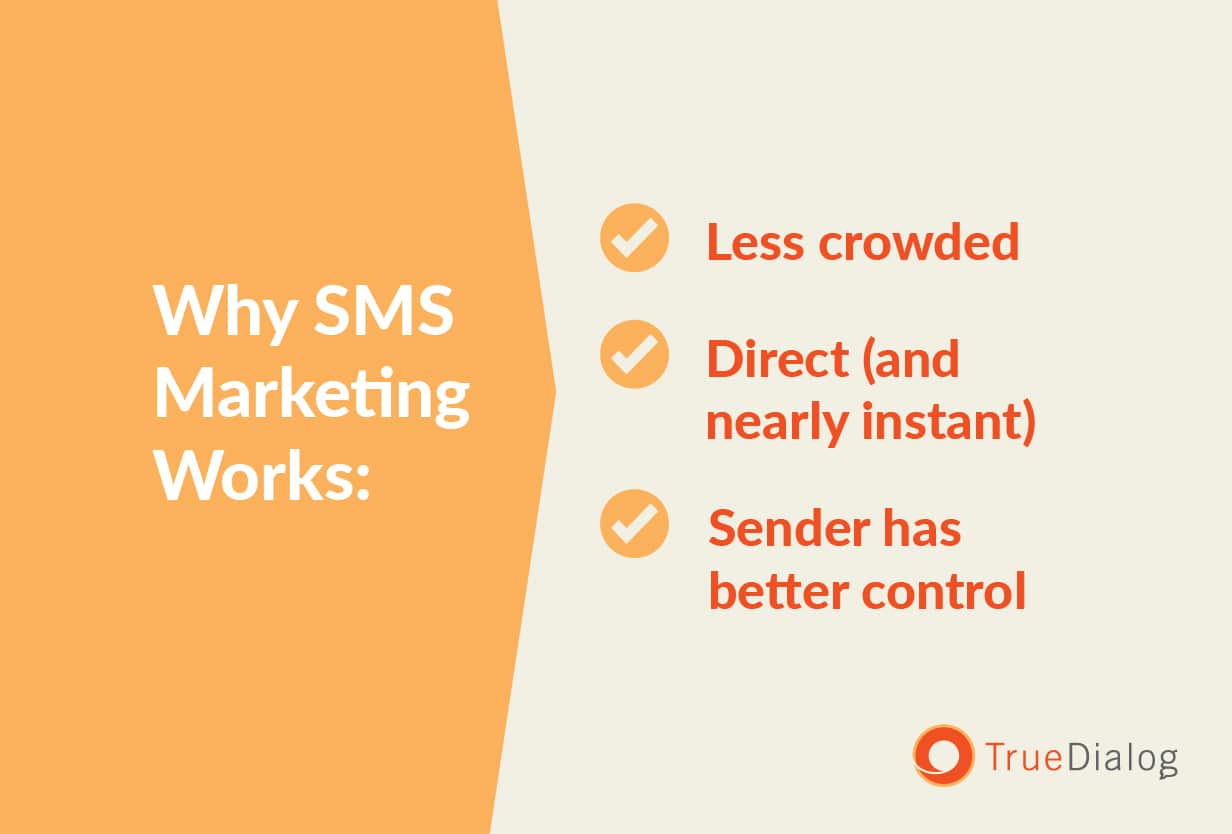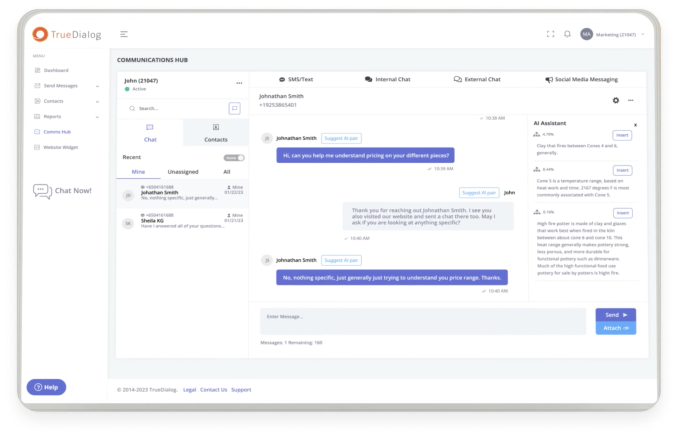People spend a lot of time on their mobile phones — and over the past couple of decades, these devices have only become more essential to daily life. Most of us no longer need physical newspapers, maps, digital cameras, or alarm clocks because, as the old Apple ad says, “there’s an app for that.”
Plus, since text messaging became mainstream in the early 2000s, it’s become our default communication mode and further cemented the desire to keep our phones within arm’s reach.
For marketers, this mobile device omnipresence creates an unparalleled opportunity to connect directly with audiences and drive action via SMS. Of course, as with any type of marketing, selecting the right medium is only half the battle — your messages also need to resonate and reach audiences when they’re most likely to engage.
To help you drive the best results, we’re sharing SMS marketing strategies and tactics employed by some of the most successful marketing teams in the world.
Why SMS Marketing Still Works
If you’ve been struggling to drive the same level of engagement you managed in the past, you’re not alone. Over the past few years, marketers across industries have lamented that it’s become increasingly difficult to reach their audiences — especially via channels that once drove the lion’s share of their conversions (like email and social media).
Yet, SMS holds steady with some of the highest engagement rates of any marketing channel — which could be why, according to a 2025 report from Dotdigital, SMS marketing sends have increased 42% in the Americas.
Here are a few key reasons why SMS marketing is still so successful, even when other efforts fall short:
- It’s less crowded: As email inboxes become increasingly oversaturated, cluttered, and chaotic, SMS inboxes stay relatively clean — which means you won’t have to fight for attention amid a barrage of other marketing messages. Because people actively monitor and check their texts far more frequently than their emails, your audience is more likely to open and engage with your SMS messages.
- It’s direct (and nearly instant): Social feeds are rarely chronological anymore, and emails can get lost in inbox filtering or labeling (not to mention the avalanche of incoming messages) — which means these channels aren’t always great options for delivering time-sensitive information like urgent updates or limited-time offers. On the flip side, text messages reach audiences in seconds. Plus, given that Americans check their phones an average of 205 times per day, according to Reviews.org, there’s a good chance they’ll see the message fast.
- You have better control: Today, standing out on social media feels like fighting an uphill battle. Not only is the ecosystem becoming increasingly fragmented, with new niche platforms appearing seemingly every week, but you’re also beholden to the whim of ever-shifting algorithms. Just as you start to build traction, an algorithm update can tank traffic overnight. But with SMS messages, your messages will always reach your audience — so long as you use a reliable enterprise SMS solution like TrueDialog that prioritizes deliverability.
How to Start SMS Marketing
Whether you’re new to marketing via text or you’re looking to uplevel your SMS strategy to drive better engagement, here are a few critical steps to take before you send your next campaign.
Get Opt-In Consent for Compliance
As a business, you’re required to get explicit permission from contacts before you can send them a text message. In other words, they need to directly agree to receiving these messages from your business — and you need to log these opt-ins to prove you’ve taken this critical step.
Many businesses use online forms to obtain consent, while others ask their audiences to send a specific keyword to a number to opt in. But regardless of which route you take, make sure you clearly state the purpose of your text messages (i.e., to send promotions or updates) and clear, easy-to-follow instructions for opting out.
Some mass texting software solutions will help you meet this compliance requirement. For example, TrueDialog offers flexible methods for opting in and unsubscribing so you can maintain clean contact lists.
Pick the Right SMS Platform
The platform you choose will have an enormous impact on whether your SMS marketing strategies flop or succeed, so it’s vital that you pick the right one.
Before you invest in a product, ask yourself:
- Does the platform have experience in my industry?
- Does the provider meet my organization’s need for robust security and regulatory
compliance? - What features or functionality does the product offer to support deliverability?
For example, TrueDialog works with organizations in higher education, sports and entertainment, financial services, and B2B software and more, and we’ve developed our solution to meet the unique needs of these industries. Our platform also has enterprise-level security certifications and supports clients in meeting regulatory requirements.
Additionally, we offer carrier lookups to identify which numbers are mobile (as opposed to landlines) and AI-powered TrueDelivery®, which checks messages for anything that may be erroneously flagged by carrier spam filters before you press send.
These features, combined with our direct carrier connections, help ensure faster and more reliable delivery, regardless of the size of your send lists.
Know Your Contacts
As a marketing leader, you know better than anyone how important it is to know your audience. Because text messages are short and simple — and your contacts have opted in to receiving them — it’s easy to assume you don’t need to put as much thought into tailoring message content. But this couldn’t be further from the truth. Because what resonates with one audience may not make sense for another. (And generic mass messaging won’t work on anyone.)
If you’re not sure where to start, take some time to reflect on your audience’s preferences, behaviors, and pain points. (What are their personal or professional goals? What keeps them up at night?) Then, use that knowledge to craft personalized and highly relevant messages.
For example, here’s a text a university might send to two different audience segments about the same event:
Graduating seniors:
Hi Carmen! Ready for the career fair on Thursday? 🤝
Bring your resume, dress to impress, and see a full list of participating employers here: [LINK]
Non-seniors:
Hi Jake! Curious about future career opportunities? 💡
Stop by the career fair on Thursday to explore and connect. See who’s coming: [LINK]
Set Clear Goals
Every successful marketing initiative begins with a clearly defined goal. Each time you send a new SMS campaign, take time to determine precisely what you want to achieve by following the SMART goal-setting framework (Specific, Measurable, Achievable, Relevant, and Time-bound).
For example, suppose a mortgage lender wants to increase business during a slow season, so they decide to set up a campaign around refinancing. They send a personalized text to a list of pre-approved homeowners to let them know that interest rates have recently dropped and it’s an ideal time to discuss refinancing.
In this case, their SMART goal might be: Increase appointments with lending agents by 20% month-over-month.
Build and Segment Your List
Once you’ve taken time to understand your audience, chosen a reliable SMS platform, set clear goals, and gathered a sizeable number of SMS opt-ins, it’s time to begin building lists and dividing your audience into segments. Depending on your industry and campaign objectives, you might segment your lists into geographical location, engagement level, point in the sales cycle, job role, or another relevant demographic.
For example, a university might create separate lists for faculty, staff, and students and then further divide its student list into segments based on class level or major. Meanwhile, a software company might divide its audience into prospects and customers.
Fortunately, it’s easy to create lists and segment your audience when you use a mass texting service like TrueDialog, so you can ensure your messages always reach the right cross-section of your audience.
Tips and Best Practices for Successful SMS Marketing Strategies
Once you’ve laid the foundation for your text marketing program, it’s time to begin developing your SMS strategies and building campaigns.
Here are a few SMS marketing best practices and proven tips to help you excel:
Personalize Your Messages
Many brands make the mistake of sending generic and impersonal messages, which can undermine engagement and even drive opt-outs. Even though it can take a little more time, personalizing your texts with the recipient’s name — and tailoring message content to each segment’s needs and preferences — can have a big payoff. These small, seemingly insignificant touches make communications feel more genuine, grab recipients’ attention, and drive contacts to engage more with your brand
Send at the Right Time
Messaging timing is vital to SMS success for two reasons: First, the Telephone Consumer Protection Act (TCPA) “quiet hours” mandate prohibits organizations from sending marketing texts between 9 p.m. and 8 a.m. (in the recipient’s time zone), and violating these rules can lead to hefty fines and penalties. Secondly, timing can impact how well your campaign drives the action you want recipients to take.
For example, a sports venue might send a text promoting a concession stand deal to attendees during the second half of the game since that’s when concession sales dip most.
Use SMS for Key Campaign Types
Texting is just one channel in your marketing ecosystem, but it’s the best choice for time-sensitive, high-impact campaigns. For example, flash sales, appointment or payment reminders, product announcements, rewards program updates, shipping notifications, or communications amid events.
Follow Compliance Rules
Remember that SMS is a permission-based channel, so you always need to provide easy ways to opt in and out of communications. You’ll also need to bake other compliance considerations into your SMS marketing strategy, including ensuring data privacy and avoiding misleading or deceptive messages.
For more on compliance requirements, check out the TCPA rules and CTIA messaging principles and best practices.
Keep Messages Short and Clear
All messages should be brief, concise, and written to be read at a glance. Keeping your messages short will make them easier to consume — plus, it’ll help you save money. (Keep in mind that carriers charge by 160-character segments. If your message exceeds 160 characters, it will count as multiple segments. Additionally, emojis may use more than one character, which can put you over the limit.)
Furthermore, brevity can be a competitive advantage in an era where everyone is inundated with information and navigating countless distractions (both online and offline).
Add a Clear Call to Action
Another essential element in any text marketing strategy is actionability. Ensure that your recipients know exactly what you want them to do when they receive your message. The easier it is to understand your call to action, the more likely contacts will do it. For example, a clear CTA might be “Reply YES to confirm” or “Tap here to book your appointment.”
Note that using public link shorteners like Bit.ly can trigger spam filters, so it’s important to choose a platform with a proprietary link shortener. TrueDialog also offers branded shortened URLs to help build brand awareness and consumer trust, which translates into higher click-through rates on your CTAs.
Creative SMS Ideas to Use Now
After building your program and mastering key SMS tips and best practices, it’s time to get creative and experiment with different types of campaigns. Here are a few ideas you can try out, plus example texts you can use as templates for your own messages:
Run Limited-Time Offers
Given how often recipients engage with their text inboxes, SMS can be the perfect channel for promoting time-sensitive deals. By setting time constraints around offers, you can create a sense of urgency and make recipients feel like they’re being included in something special (which is helpful when you want to boost ticket sales, product sign-ups, and overall engagement).
Example:
Psst! José, you’re in! 🥳 We’re running a surprise presale through midnight. Grab your tickets to the All-Star Game before they’re gone: [LINK]
Send Event Invitations
Text invitations are an excellent way to spark interest in an event and boost attendance. Unlike email invites, which can feel daunting amid an inbox full of to-dos, text invites allow recipients to quickly RSVP on the go. It’s also easy for people to forward and share with friends and colleagues who may be interested in joining.
Example:
Hi Madeline! Join us for our campus Fall Fest this Friday at 3PM! Live music, free food, and door prizes 🎉 RSVP here: [LINK]
Share Appointment Reminders
In today’s busy world, it’s not unusual for people to forget about appointments and scheduled events. But no shows and late appointments can be costly and have a knock-on effect across your entire schedule. Fortunately, a well-timed, automated SMS reminder can help remedy this issue by giving contacts a gentle nudge and an opportunity to reschedule before it’s too late.
Example:
📅 Hi Alex, your virtual investment account review is on Wednesday at 2 PM. Reply “YES” to confirm or click here to reschedule: [link]
Try Two-Way Messaging
One of the great benefits of using SMS to communicate with your audience is that it can be interactive. Instead of merely talking “at” contacts, you can start real-time conversations — which is perfect for requesting feedback, providing customer support, or running a text-to-vote campaign.
Example:
Hi Hana! 👋 How was your experience with our new support hub today?
1 for Extremely easy
2 for Ok
3 for Needs work
4 for Frustrating
Start Strong with the Right SMS Platform
Text messaging is one of the best ways to reach audiences today. It can help your organization cut through the noise, cultivate meaningful audience relationships, and drive engagement even when other channels fall short. By using the tips, examples, and best practices in this SMS marketing guide and — a reliable enterprise SMS platform like True Dialog — you’ll be well on your way to exceeding your marketing goals.
Learn how TrueDialog can power your SMS marketing program and help you scale fast. Request a demo today.







